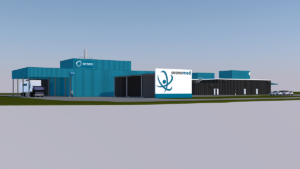
KOLs see paradigm shift in the diagnosis and treatment of common disesases
It's still under the radar of analysts. However, the vasoactive peptide adrenomedullin could become the Next Big Thing in therapy monitoring and the treatment of disorders caused by endothelial dysfunction such as acute heart failure, or septic shock. During a scientific symposium Endothelial Dysfunction - Adrenomedullin as a diagnostic and therapeutic target (19. December 2017, Berlin), 15 international medical key opinion leaders from ICU/ED's for the first time compiled clinical data from more than 10,000 patients that underscore that adrenomedullin could lead to a paradigm shift in the diagnosis, monitoring and treatment of disorders linked to endothelial dysfunction.
Dysfunction of the vascular endothelium has been linked to a broad spectrum of the most dreadful human diseases, such as peripheral vascular disease, stroke, heart disease, diabetes, chronic kidney failure, and metastasis. However, until recently there was no way either to predict, to monitor or to prevent the impaired fluid balance caused by leaky blood vessels. Now, clinical data provide evidence, that high plasma levels of the peptide hormone adrenomedullin indicate a dysfunctional barrier function of the endothelium. In sepsis, high plasma levels of adrenomedullin predict a negative outcome. The multifactor systemic inflammation without causative treatment is responsible for nearly $24bn in direct annual costs for the US healthcare system.
A dysfunctional barrier function of the endothelium leads also to severe complications in heart failure patients. A growing amount of clinical data suggest that high adrenomedullin levels can also identify patients with congestive acute heart failure who do not respond to loop diuretics therapy. Readmissions of therapy-resistant patients lead to a good part of the current AHF healthcare cost of $31bn, which are predicted to double by 2030.
At the end of December 2017, international key opinion leaders (KOLs) and decision makers from Big Pharma and diagnostic majors met in Berlin to discuss clinical data suggesting the vasoactive peptide hormone adrenomedullin is a key regulator in endothelial integrity and could be used both as a diagnostic biomarker indicating endothelial dysfunction as well as a target to treat vascular dysfunction in septic shock and decompensated acute heart failure (AHF)
Prof. Dr. Salvatore di Somma, Director Emergency Medicine at University La Sapienza in Rome, presented data from a pilot study (N=100), which proved for the first time that the bioactive, amidated form of the adrenomedullin (bio-ADM) is highly predictive for the development of septic shock. Using the only available commercial assay (Sphingotec GmbH, Berlin, Germany) that detects bio-ADM, he showed that the functional endothel marker also allowed therapy monitoring in shock patients. Di Somma’s initial findings in sepsis and shock patients with heterogenous disease etiology and co-morbidites was confirmed in multiple large clinical studies.
Several clinical trails (ALBIOS, N=1,000, AdrenOSS-1, N=583, and FROG-ICU, N=2084) demonstrated that bio-ADM is a biomarker for endothelial dysfunction in sepsis patients at intensive care units (ICUs): A biomarker study within ALBIOS conducted by Prof. Dr. Roberto Latini (Head Cardiovascular Research, Mario Negri Institute, Milan) showed that bio-ADM plasma levels above 70pg/ml were predictive of organ dysfunction and shock. Data from AdrenOSS-1 and FROG-ICU, presented by Prof. Dr. Alexandre Mebazaa (Hôpital Lariboisière, Paris), clearly qualify baseline bio-ADM levels as a predictor for vasopressor demand. Furthermore, a study conducted in emergency departments (ED) by Prof. Dr. Olle Mellander (Lund University, Malmö), showed that high bio-ADM levels were associated with a 13-fold higher risk for mortality vs bio-ADM levels below the cut-off (70 pg/ml) in ED patients. This qualifies the biomarker for early recognition of ICU requirement. Data from recent studies conducted in Aachen (Germany, Prof. Dr. Gernot Marx) and Seoul (South Korea, Prof. Mina Hur) further expand the patient pool for which bio-ADM predicts outcomes and early requirement for supportive therapy. In a small cohort of surgical sepsis patients (N=42) Marx confirmed that bio-ADM is predictive for mortality, organ failure, vasopressor demand and disease severity. In 215 patients with septic shock, Hur confirmed, that high bio-ADM levels at baseline are also a predictor of 30-day mortality and organ dysfunction in Asian patient populations.
According to serial entrepreneur Andreas Bergmann, co-founder of diagnostics player BRAHMS, Sphingotec and Adrenomed, bio-ADM indicates endothelial dysfunction and thus the need of vascular repair. The marker is not limited to indications such as septic shock but is a general indicator of endothelial dysfunction – also in heart failure.
A growing amount of clinical data suggest that congestion in heart failure patients is strongly linked to endothelial dysfunction: low pump efficiency of the heart caused by cardiac remodeling results in congestion – high venous pressure cause the microvasculature to get leaky and fluids to build up in the tissues (edema) in up to 80% of patients. Thus, bio-ADM appeared to be the ideal diagnostic biomarker for congestion.
Studies (PROTECT and BIOSTAT) on 4,000 patients with decompensated acute heart failure (AHF), presented by Prof. Dr. Adriaan Voors from UMC Groningen, demonstrate that bio-ADM clearly differentiates patients with a high congestion score – which reflects the amount of edema, jugular venous pressure and orthopnea – from patients with less symptoms. Furthermore, high-ADM levels were predictive of 180-day mortality.
Most important, high bio-ADM levels at baseline predicted residual, diuretic-resistant congestion at discharge. Residual congestion caused by limited response to diuretics is the major reason for re-hospitalization and post-discharge mortality of AHF patients. However, up to today there was no biomarker able to diagnose and to predict residual congestion. In the 5-year BIOSTAT study, which compared bio-ADM with 160 other biomarkers, Voors’ team confirmed that bio-ADM had the best predictive power relating to the probability of rehospitalisation due to congerstion, residual congestion and mortality due to congestion..
These findings are backed by results of the GREAT study (Paris, Basel, Leicester) on 1,884 patients with decompensated acute heart failure (AHF). According to cardiovascular expert Prof. Dr. Leong Lg (Leicester), bio-ADM levels at the day of discharge identified the need to continue decongestive therapy. Because patients with incomplete decongestion have a high risk of relapse, high bio-ADM levels also predicted the 90 day survival rate. Results from the Val-HeFT study (N=583), reported by Prof. Dr. Inder Anand, Head Cardiovascular Medicine at the University of Minnesota, confirmed that bio-ADM is also a marker for congestion in patients with chronic congestive heart failure.
According to Fernando Chavez, Global Head at Ortho Clincal Diagnostics, which recently licenced Sphingotec’s bio ADM assay, the economic impact of the findings could be huge as residual congestion affects 1.1 million AHF patients in the US alone.
Discussing the primary clinical utility of bio-ADM, KOLs at the meeting agreed that monitoring of treatment success in patients with endothelial dysfuntion must have priority followed by stratification and early treatment of patients at high risk of life-threatening events and re-hospitalisation. However, several clinical trials suggest that bio-adrenomedullin might be also an attractive therapeutic target to treat congestion in AHF and to lower mortality in septic shock.
According to Prof. Dr. Peter Pickkers (Radboud University, Nijmegen) targeting of adrenomedullin with a humanized antibody (Adrecizumab, Adrenomed AG, Hennigsdorf/Berlin) that targets the N-terminus instead its receptor-binding C-terminus improved fluid balance, blood pressure in resuscitated rat and pig models for sepsis. In a mouse model for sepsis Adrecizumab led to a 40% overall survival benefit. Preclinical results suggest that the antibody leads to a immediate re-distribution of adrenomedullin from the interstitial space to the vessel lumen, without triggering its production. The shift from tissue to the vessel promotes stabilization of the endothelial barrier while preventing vasodilation, which adrenomedullin triggers when located in tissue.
In humans, Adrecizumab has shown an excellent safety profile in two Phase I trials. In December 2017, it entered a multicentre Phase II proof of concept study in 300 patients with early septic shock. According to Prof. Pierre-François Laterre (St. Luc Hospital, Brussels), patients will be stratified using high bio-ADM levels as inclusion criterion. bio-ADM-based stratification is expected to identify a patient collective with reduced heterogeneity, which is most likely to benefit from treatment. Besides mortality, endpoints include the number of days with organ support (SSI) and 90-day safety.
Adrenomed will also start a multi-centre Phase II trial with Adrecizumab in up to 360 patients with worsening heart failure in 2018. According to Prof. Dr. Adriaan Voors, many of the 20-30% of AHF patients that are rehospitalised (at a cost of $5,000 per patient and day) are currently discharged with residual tissue congestion. So, an antibody, which triggers redistribution of adrenomedullin from tissue to the intravascular space by factor 10 like Adrecizumab does, could counteract tissue congestion. Endpoints under discussion include safety, time to rehospitalisation, clinical congestion score, clinical lab parameters etc.
Representatives of diagnostic and pharma companies said at the meeting that they see large potential in the new approach to stratify patients based on bio-ADM levels and subsequently target endothelial dysfunction.


 Orano Med SA
Orano Med SA fvm.dk
fvm.dk Office of Congresswoman Ayanna Pressley - https://pressley.house.gov/press-kit/
Office of Congresswoman Ayanna Pressley - https://pressley.house.gov/press-kit/